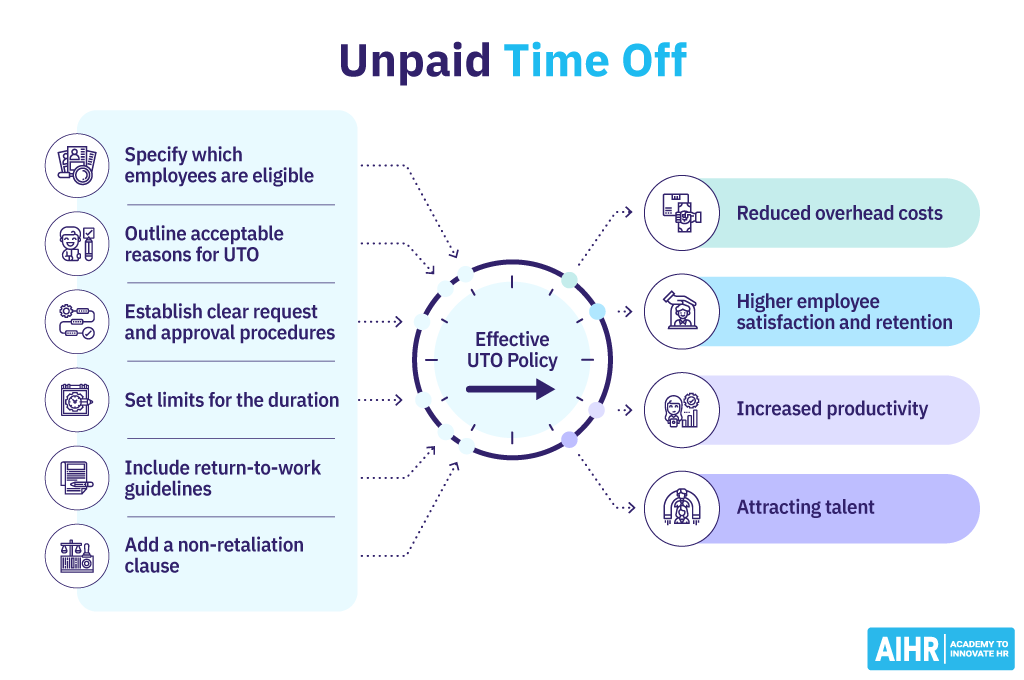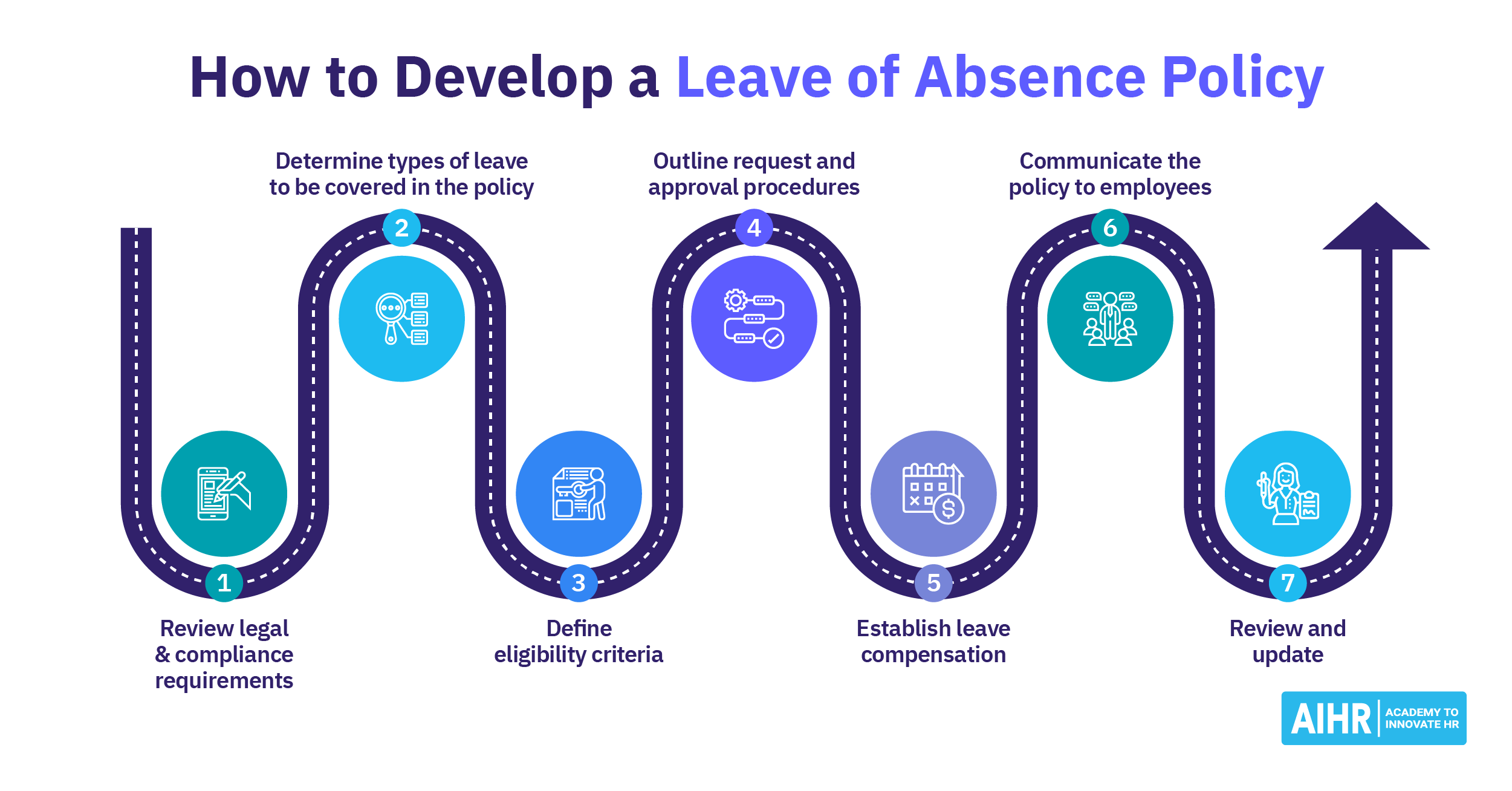Unpaid Time Off
What is unpaid time off?
Unpaid time off (UTO) refers to time away from work an employee is allowed to take without receiving pay. This type of leave differs from paid time off (PTO), which covers vacation days or paid sick leave, where employees still receive their usual salaries.
The decision to grant UTO and the number of UTO days available is at the employer’s discretion, unless regulated by labor laws or specific contractual agreements. It’s usually not part of standard annual leave, and can be considered a type of personal leave.
Some common reasons for taking UTO include:
- Bereavement: Extending bereavement leave beyond provided paid leave for dealing with the death of a close family member.
- Personal illness or injury: This could include managing severe injury or personal health issues.
- Mental health breaks: Taking time off to deal with stress, burnout, or other mental health concerns when paid leave is unavailable or insufficient.
- Unforeseen emergencies: Responding to personal or family emergencies not covered by other types of leave.
- Volunteering: Participating in volunteer work or community service projects that require a significant time commitment.
- Travel and leisure: A period of leave for travel, study, or rest, especially after several years of continuous work.

Advantages and disadvantages of offering unpaid time off
Below are the main advantages and disadvantages of offering employees UTO:
Advantages
- Reduced overhead costs: UTO can help reduce payroll expenses during slow periods or when financial constraints arise. This flexibility can help manage business budgets more effectively.
- Higher employee satisfaction and retention: Allowing additional time off can improve job satisfaction and work-life balance, appealing to employees who need additional time for personal reasons or who simply prefer flexibility over higher pay.
- Attracting talent: Some candidates prioritize personal time over more compensation or have caregiving responsibilities that lead them to opt for flexible work arrangements. Offering UTO can make an employer more attractive to such potential hires.
- Increased productivity: Employees who take time off to recharge, even if they are unpaid, often return to work more focused and productive. Allowing employees to take breaks when needed can prevent burnout and maintain greater long-term productivity.
Disadvantages
- Operational disruption: Employee absences can disrupt workflows, especially in small teams or critical roles, leading to delays and increased pressure on other team members.
- Increased administrative burden: Managing UTO requires administrative oversight, which can increase the workload for HR departments. This includes tracking the time off, ensuring compliance with labor laws, and adjusting payroll accordingly.
- Excessive unpaid time off: Without strict policies and monitoring, there’s a risk some employees might abuse the UTO policy, taking excessive time off that could disrupt business operations and affect team dynamics.
- Difficulty in planning and scheduling: Frequent or unpredictable leave can make it challenging for managers to plan and allocate resources effectively, complicating operations in industries requiring consistent presence.
Paid time off vs. unpaid time off
When comparing UTO and PTO, there are several key differences to consider:
Definition
Time off from work, during which employees are still paid.
Time off from work without pay.
Benefits
Maintains income continuity, and often includes vacation, sick leave, and personal days.
Provides time off when no other options are available, at no financial cost to the company.
Usage restrictions
Typically used for vacations, sick days, and personal matters.
Often used for extended leaves (e.g., long-term care or sabbaticals) beyond what PTO covers.
Company policy
Usually clearly defined in terms of accrual rates, caps, and conditions of use.
Often less structured, and may require approval on a case-by-case basis.
Legal entitlement
Varies by country and state; some jurisdictions mandate certain types of paid leave.
Generally not legally required; subject to company policies and local labor laws.
Unpaid time off laws
In general, the decision to grant employees unpaid leave rests in the employer’s hands. However, there are circumstances under which businesses must comply with state or federal employment laws that mandate authorized leave. Here are some examples:
- Family and Medical Leave Act (FMLA): Allows qualified employees to take up to 12 weeks of unpaid, job-protected leave per year for specified family and medical reasons, such as the birth of a child, personal or family illness, or military leave considerations.
- Uniformed Services Employment and Reemployment Rights Act (USERRA): Protects the employment rights of employees who voluntarily or involuntarily leave their jobs to undertake military service, including providing unpaid leave.
- Americans with Disabilities Act (ADA): Requires employers to consider unpaid leave a form of reasonable accommodation for employees with disabilities, provided it does not cause the business undue hardship.
Create impactful compensation & benefits packages
Leave is an essential part of a competitive total rewards strategy. You need the right expertise to create policies that balance compliance, business goals, and employee wellbeing.
Enroll in AIHR’s Compensation and Benefits Certificate Program and gain the skills to develop strategic, equitable, and effective total rewards policies.
Can an employer deny unpaid time off?
An employer can deny unpaid time off unless specific laws or company policies require otherwise. Unlike paid leave, which often has structured policies, taking unpaid time off is generally at the employer’s discretion.
Employers may deny unpaid leave requests if:
- The absence would cause significant operational disruptions
- The request does not align with company policy
- The employee does not meet eligibility criteria, such as tenure or performance standards
- The requested time off conflicts with business needs, especially during peak seasons.
However, certain laws require employers to grant unpaid leave under specific conditions, such as the Family and Medical Leave Act (FMLA) and the Americans with Disabilities Act (ADA). Employers should ensure their policies comply with labor laws while balancing business needs.
How to calculate UTO and PTO for salaried employees
Calculations for time off for salaried employees depend on whether the time off is paid or unpaid. Since salaried employees receive a fixed salary regardless of hours worked, taking unpaid time off requires specific calculations to adjust their pay accurately.
For UTO, first determine the employee’s daily pay using the following formula:
| Daily pay rate = | Annual salary / Total workdays per year (usually 260 for full-time, five-day workweeks) |
Next, multiply this by the number of days of UTO taken, and deduct the result from the employee’s paycheck:
| Unpaid time off deduction = | Daily pay rate x Total UTO days taken per year |
For example, an employee earning $65,000 annually takes three unpaid days off in one year. You would therefore calculate the following:
- Their daily pay rate: $65,000 annual salary / 260 workdays per year = $250
- Their UTO deduction: $250 daily pay rate x 3 UTO days taken = $750
For PTO, many companies provide it based on accrual systems or lump-sum allocations. The standard accrual formula is as follows:
| Standard PTO accrual = | Annual PTO allowance / Total work periods (e.g., per month or pay period) |
For instance, an employee who has 15 PTO days per year and accrues leave monthly would earn 1.25 PTO days per month. If they take five days off, their balance is reduced to 10 days, with no salary deduction.
For companies that allow negative PTO balances, employees may take extra paid leave, with deductions made from future accruals or paychecks if they leave before replenishing their balance.
Employers should document these calculations clearly in payroll records and communicate policies to employees to ensure transparency when taking UTO or PTO.
HR tip
Encourage open communication between employees and managers regarding unpaid time off requests. By fostering a culture of transparency and flexibility, an organization can promote a healthy work-life balance while maintaining productivity and compliance with relevant laws and regulations.
Unpaid time off policy: What to include
Creating a well-defined UTO policy involves clear communication, considering legal requirements, and balancing the organization’s needs with those of its employees. It can also be included in your general leave of absence policy. Here’s a step-by-step guide for HR professionals:
- Define the eligibility criteria: Specify which employees are eligible (e.g., full-time, part-time, temporary) and if there are any employee tenure requirements before employees can request UTO.
- Reasons for UTO: Clearly outline acceptable reasons for requesting unpaid time off. These can include personal or family health issues, educational pursuits, volunteer work, unforeseen emergencies, and travel and leisure. Consider including a clause that addresses other reasons on a case-by-case basis.
- Request and approval procedures: Establish clear guidelines for employees to request UTO and outline the approval process, including who has the authority to grant or deny requests.
- Duration and limits: Set clear limits on the duration of UTO an employee can take, whether it’s a continuous period or an aggregate over one year.
- Return to work: Outline expectations and procedures for returning to work after UTO, whether employees need to confirm their return date in advance, and if any reintegration measures are necessary.
- Non-retaliation clause: Assure employees that taking unpaid leave will not result in retaliation or adverse employment actions. This provides a sense of security for employees considering UTO.
Examples of unpaid time off policies
- Educational leave: Employees are allowed up to 12 weeks of unpaid leave for educational purposes, provided they are enrolled in an accredited program related to their job.
- Sabbatical leave: After five years of continuous service, employees may be eligible for a one-time, six-month unpaid sabbatical to pursue personal or professional development activities.
- Volunteer time off: Employees can take up to two weeks of unpaid leave annually to participate in volunteer activities with approved nonprofit organizations.
FAQ
Yes, salaried employees can take unpaid time off if their company’s policies allow it. The availability and conditions of such leave depend on the employer’s specific policies, and applicable labor laws.
Employers can deny unpaid time off based on operational requirements, staffing needs, or if the request does not comply with the company’s policies or the conditions outlined in employment contracts. Employers must also consider applicable labor laws to ensure any denial meets legal standards.
Unpaid time off is typically not unlimited. Employers usually set limits and conditions based on company policy, operational needs, and legal requirements. The amount of unpaid leave an employee can take usually depends on the employer’s discretion and the specific circumstances of the request.









